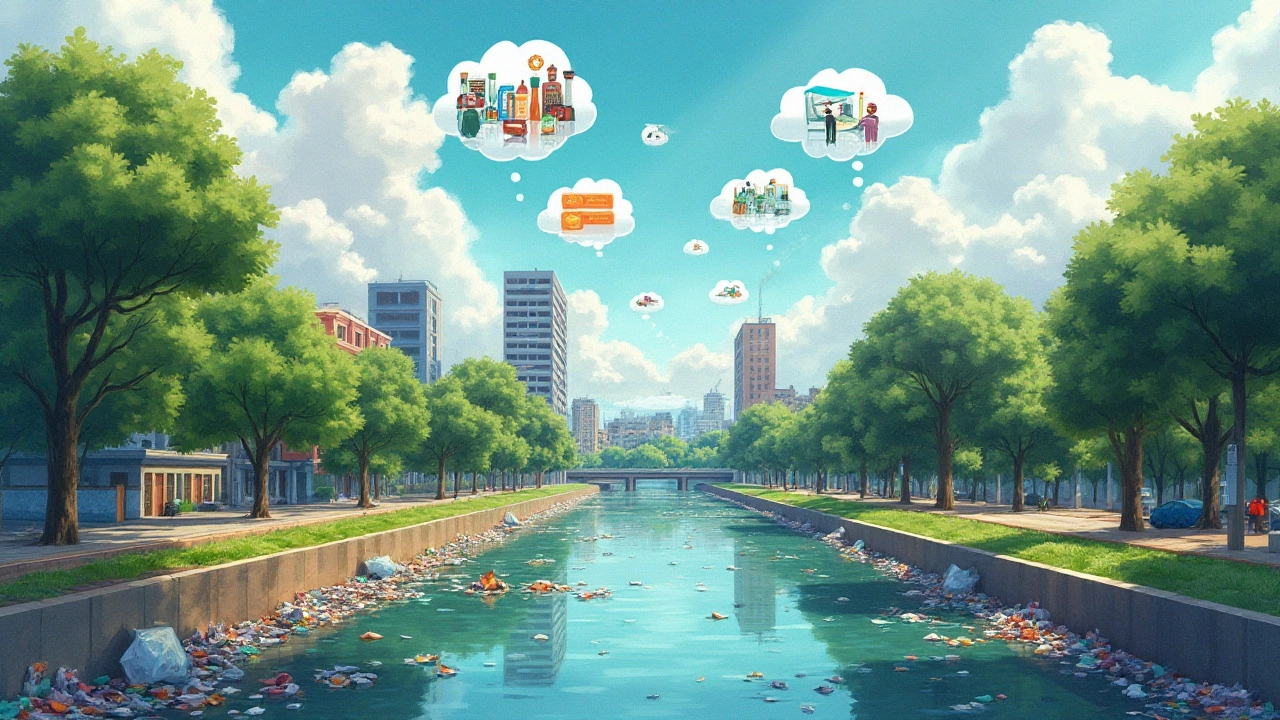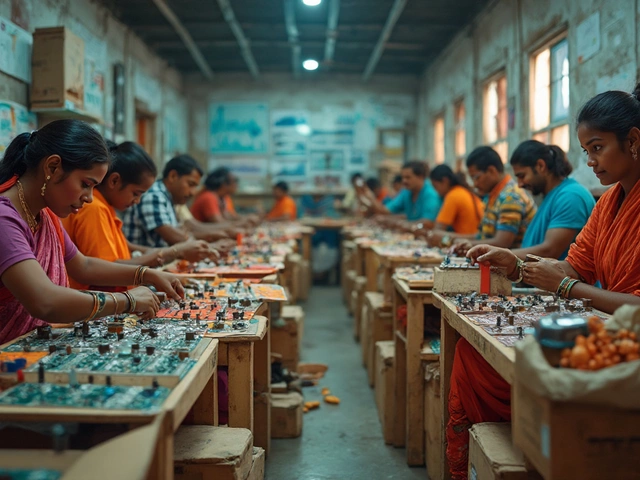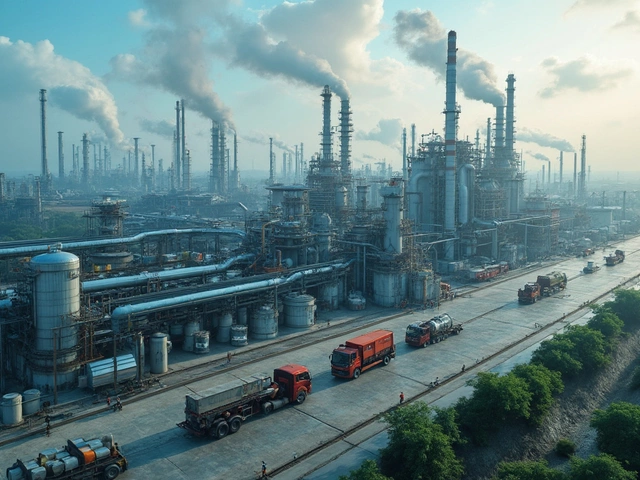Plastic is everywhere, from the depths of the oceans to the peaks of mountains. Its convenience is undeniably attractive, yet the environmental toll is impossible to ignore. As we unravel the story of plastic, it's crucial to understand who should take responsibility for this global predicament. Is it the manufacturers turning out billions of tons annually, or should the onus be on the consumers who demand and discard?
The truth is, pointing fingers won't resolve the issue. A holistic approach that involves all stakeholders—from governments to industries, and yes, even the consumers—holds the key. In this article, we'll delve deep into the roots of plastic pollution, shedding light on the crucial roles played by manufacturers, and exploring potential pathways to a sustainable future where plastic doesn't have the final say.
- The Rise of Plastic Pollution
- Plastic Manufacturers: Role and Responsibility
- Government Policies and Regulations
- Consumer Choices and Their Impact
- Innovative Solutions for a Sustainable Future
- Taking Collective Action
The Rise of Plastic Pollution
The modern age of plastic began in the early 20th century, revolutionizing industries and daily life. With its introduction, plastic offered a world of convenience and versatility—a material that could transform into virtually any shape, offering durability at a low cost. By the 1950s, industrial-scale production was in full swing, setting the stage for what would become a global obsession and, inadvertently, a significant environmental burden. As of the latest data, an estimated 8.3 billion metric tons of plastic have been produced worldwide, with more than 60% of that becoming waste.
The surge in plastic production coincided with the advent of the throwaway culture. Single-use items rapidly became the norm, infiltrating sectors from packaging to healthcare. This culture of disposability further exacerbated the plastic pollution crisis, leading to staggering levels of waste. Between 1950 and 2015, plastic production soared by 8.6% annually, outpacing most other man-made materials. This explosive growth, while economically beneficial, posed increasingly evident environmental threats.
Our oceans bear the brunt of the impact. An estimated 8 million tons of plastic waste end up in the oceans every year, harming marine life and threatening ecosystems. Images of wildlife entangled in plastic have become distressingly common, underscoring the urgent need for action. A substantial amount of oceanic plastic debris can be traced back to plastic manufacturing companies, highlighting the need for accountability and responsibility in production processes.
Despite the bleak outlook, awareness of the plastic pollution crisis is growing, leading to incremental changes and enforcement of policies to curb waste. Several nations have embraced the urgency, banning certain forms of single-use plastics and incentivizing recycling efforts. Innovators and conservationists are actively searching for alternatives and ways to repurpose existing waste, although much remains to be done.
"The greatest threat to our planet is the belief that someone else will save it," noted environmentalist Robert Swan. This reflection calls to mind the pressing need for collaborative action among all stakeholders to address the burgeoning problem of plastic waste.
The history of plastic pollution is not just one of environmental degradation, it is also a story of human ingenuity meeting its darker side. As we contemplate solutions to this intricate problem, the lessons learned from the rise of plastics are crucial in understanding how we might redirect the future of this material from pernicious to positive.
Plastic Manufacturers: Role and Responsibility
Plastic manufacturing has undeniably carved a significant niche in modern industry, giving birth to products that now permeate every facet of daily life. From packaging materials to consumer goods, plastic provides unparalleled convenience and cost-effectiveness. Yet, with the mass production of these non-biodegradable materials, an urgent environmental crisis has emerged. The industries involved in this manufacturing carry a substantial weight of responsibility not merely for creating these products but for the vast quantities of waste generated as a result. It's paramount to understand that manufacturers have the power to drive change, helping to mitigate the impact by rethinking their production processes and product designs. Delving deeper, plastic producers often focus heavily on economics, aiming to meet consumer demands at competitive prices, which inadvertently prioritizes production levels over sustainability. The result is evident in the statistics: each year, around 300 million tons of plastic are produced globally, with only a small percentage being recycled. The majority, alarmingly, ends up in landfills or becomes litter, impacting wildlife and ecosystems profoundly.
Recent years have witnessed a growing call for manufacturers to adopt more sustainable practices and to take accountability for the afterlife of their products. This includes not only adjusting their supply chain to incorporate recycled materials but also engaging in extended producer responsibility (EPR) initiatives, which involve taking back products at the end of their life cycle. Such commitments are beginning to gain ground within the industry. For instance, some of the world's largest conglomerates have pledged to reduce virgin plastic usage in favor of materials that support a more circular economy. A 2019 report by the Ellen MacArthur Foundation highlighted that over 250 organizations are committed to achieving 100% reusable, recyclable, or compostable plastic by 2025.
Yet, the road forward is laden with challenges. Implementing such changes requires substantial investment in new technology and infrastructure, and at times, entirely reinventing traditional business models. To this end, innovation is paramount. Companies like Loop Industries are exploring new recycling technology that breaks down plastics to their basic elements, allowing for more efficient reuse. Concurrently, there's an increasing push for legislation demanding higher recycling rates and banning single-use plastics. Interestingly, some regions have already enacted bans on plastic bags and straws, signifying a shift in both regulatory landscapes and public sentiment.
The responsibility should not rest solely on manufacturers but must be a collaborative effort with governments and consumers. Regulations can provide the necessary framework that nudges companies toward better practices, while public demand can spur further innovation and adaptation. A path forward may include the development of stronger alliances between industry leaders and policymakers, ensuring that sustainable practices are not only encouraged but mandated. An efficient and lasting response to plastic pollution thus depends heavily on these multifaceted collaborations. As a former UN Secretary-General once aptly said,
"Only by working together can we create a more sustainable and prosperous future for all."
Government Policies and Regulations
The battle against plastic pollution has propelled governments worldwide to devise policies and regulations aimed at curbing this menace. One of the cornerstone policies impacting the prevalence of plastic is the implementation of plastic bans and restrictions. Many countries are adopting measures that limit the production and use of specific plastic products, such as single-use plastics. For example, the European Union has taken significant steps by banning single-use plastic items like cutlery and straws, a rule that came into effect in 2021. Such directives are crucial in reducing the amount of waste polluting our ecosystems and setting the stage for more sustainable practices in plastic manufacturing.
In addition to bans and restrictions, many nations have introduced economic instruments such as taxes and incentives aimed at driving change within the industry. Denmark, for instance, was one of the first countries to implement a plastic bag tax, a move that has dramatically reduced usage. These taxes inject a level of accountability and encourage both consumers and manufacturers to shift towards more sustainable alternatives. Moreover, subsidies and financial incentives for companies that opt for biodegradable materials or actively reduce their plastic footprint illustrate a proactive approach embraced by forward-thinking governments aiming to eradicate plastic pollution.
Regulations aimed at enhancing recycling processes are also gaining prominence. Countries like Germany have established robust recycling systems where mandatory deposits are imposed on plastic bottles encouraging returns and recycling. These systems not only alleviate the stress on existing landfill sites but also support the idea of a circular economy where materials are reused rather than wasted. As articulated by Ban Ki-moon, the former Secretary-General of the United Nations,
"We have only one planet, and we cannot save it without sustainability at the heart of corporate and political agendas."Emphasizing recycling efforts and promoting sustainable practice, regulations can reshape consumer behavior and manufacturer protocols alike.
Yet, even the most stringent policies require enforcement and public collaboration to realize their potential. The challenge lies not only in the formation but also in the application and monitoring of such regulations. For effectiveness, these must be supported by public education campaigns that inform citizens about the reason behind these changes and encourage a shift in consumer habits. Government initiatives that are closely aligned with educational campaigns reflect a two-pronged approach that not only sets the groundwork for reduced environmental impact but also garners public support and comprehension.
On a global scale, organizations like the United Nations Environment Programme (UNEP) are crucial facilitators of policy development and enrichment. UNEP’s global plastic partnership emphasizes international collaboration and policy integration, motivating nations to work together towards global solutions. This cooperative model encourages the sharing of best practices and insights, catalyzing effective legislative frameworks tailored to individual country challenges. While policies are paramount in addressing the immediate issues of the plastic crisis, the intricacies involved demand adaptability and a readiness to innovate to keep pace with evolutions in both technology and society.

Consumer Choices and Their Impact
When it comes to tackling plastic pollution, the purchasing decisions that individuals make every day play a surprisingly powerful role. Each choice, from selecting a brand of bottled water to deciding whether to carry a reusable shopping bag, adds up to either exacerbate or mitigate environmental issues. On a global scale, consumer demand significantly influences the actions of plastic manufacturing companies, encouraging them to supply products laden with plastic or pay heed to greener alternatives. Just as fashion trends can sway an entire industry, the quest for eco-friendliness can nudge these manufacturers towards adopting sustainable packaging and practices.
There's an undeniable pattern: as consumers become more eco-conscious, they seek transparency and sustainability in the products they purchase. A 2023 survey revealed that more than 70% of shoppers consider environmental factors when buying products. This shift in mindset compels companies to reformulate their offerings, ensuring they meet consumer expectations. In the UK alone, the sales of reusable water bottles surged by 50% between 2018 and 2022, reflecting this burgeoning awareness.
Yet, shifting consumer behavior requires overcoming convenience, often a significant barrier. Single-use plastics remain a quick fix for many, from takeaway containers to grocery bags. Awareness campaigns aim to change this mindset, emphasizing that individual actions have cumulative effects. Interestingly, people who actively reduce their plastic footprint often inspire their communities, acting as catalysts for broader change. A dedicated individual can indeed spark a ripple effect in their locality, underscoring the power of personal choices in addressing vast environmental challenges.
Green Trends and the Push for Change
With the rise of the environmental movement, certain trends have emerged that further influence consumer behavior. From adopting sustainable fashion to choosing organic products, individuals are more attuned to the environmental impact of their purchases. Many have turned to minimalist lifestyles, rejecting unnecessary packaging and choosing products that leave a smaller carbon footprint. Global movements such as "Plastic Free July" encourage millions to challenge themselves to refuse single-use plastics, demonstrating collective momentum towards sustainability.
"What you do makes a difference, and you have to decide what kind of difference you want to make," said Jane Goodall, renowned environmentalist.
However, this increased awareness among consumers is not uniform globally. In regions where economic constraints limit options, single-use plastics remain prevalent due to cost-effectiveness. This underscores the need for global cooperation and policy-driven solutions to provide affordable sustainable alternatives. Education becomes paramount, guiding consumers on eco-friendly choices while emphasizing the collective benefits of reducing environmental impact.
How to Be Part of the Solution
Stepping up as a conscientious consumer means making intentional, informed choices. Opt for products with minimal or no plastic packaging, and support brands that prioritize sustainability. Many consumers have shifted to purchasing in bulk to reduce waste. Simple steps, such as always carrying a reusable bag or refusing plastic straws, are accessible and effective. When shopping, look for certifications that indicate eco-friendly practices, such as "B Corp" or "Fair Trade." Advocacy also plays a role: writing to local representatives to support plastic reduction initiatives or joining local clean-up drives fosters a culture of change. Engaging with your community amplifies the message, encouraging others to pursue eco-friendly lifestyles and make decisions that reduce reliance on plastics.
Innovative Solutions for a Sustainable Future
In the fight against plastic pollution, innovation emerges as both a savior and a spark for hope. Companies and scientists alike are diving headlong into groundbreaking ideas that promise to redefine how we produce, consume, and dispose of plastics. One of the most promising developments is the advent of biodegradable plastics. These materials, designed to break down more rapidly under natural conditions, could offer a green alternative to traditional plastics, which can linger in the environment for centuries. Imagine a world where discarded plastics transform back into natural elements within months, not millennia. Although challenges remain around the scalability and cost of production, each step forward echoes a powerful promise for cleaner ecosystems.
Besides biodegradable options, the concept of a circular economy is revolutionizing how we view waste. Instead of a linear 'make, use, dispose' approach, the circular economy encourages designing sustainable products that can be reused, repaired, and recycled ad infinitum. This idea shifts the burden from merely managing waste to transforming it into a resource. Companies and governments are coming together to create closed-loop systems where plastic waste is not an endpoint but a valuable input for new products. It's a shift that could redefine industries and consumption patterns.
Coupled with technological advancements, some trailblazers are harnessing the power of AI and robotics to improve plastic sorting and recycling processes. By enhancing the efficiency and accuracy of waste management, we can increase the amount and quality of recycled materials. As operations become more streamlined, the landscape of plastic recycling is transforming, encouraging more players to jump on board. According to a report from the McKinsey Institute, investments in AI technologies could enhance recycling efficiency by up to 50% in the coming years, drastically reducing plastic waste piling up in landfills.
Public and corporate green initiatives are also mobilizing solutions. With consumer demands for sustainable practices on the rise, many businesses are reinventing their packaging strategies. Companies like Unilever have committed to making all of their plastic packaging fully recyclable, compostable, or reusable by 2025. This trend is not just a marketing ploy but a substantial move towards tangible change across the industry. As these pledges transform into action, there is potential for significantly decreasing pollution rates, setting a precedent for others to follow.
Amidst all these efforts, one cannot overlook the subtle yet crucial role played by education and awareness in driving innovation. From NGOs to grassroots movements, there's an active push to educate both individuals and industries about the consequences of plastic misuse and the opportunities that lie in rethinking our relationship with this ubiquitous material. By fostering a culture of creativity and commitment, we plant the seeds for a future brimming with less plastic waste and more ingenuity. Encouraging young minds to innovate and challenge the status quo can lay down a legacy that shapes the future of plastic manufacturing.
Case Studies and Global Efforts
Several case studies reflect the emerging tide of change sweeping the globe. In 2019, the Ocean Cleanup project undertook an ambitious task to rid the oceans of massive plastic garbage patches, employing a floating system designed to drift and collect waste for later recycling. After several trials and adjustments, the initiative has made significant strides, collecting thousands of kilograms of ocean plastic, reshaping our approach to addressing pollution in maritime environments.
“Innovative thinking is the buzzword for tackling the challenges of the 21st century,” said Professor Emily Harwood from the Sustainable Development Institute. “Creating sustainable systems is not solely about technology. It needs holistic thinking that integrates people, planet, and profit.”
From the grassroots level to global initiatives, innovative solutions for a sustainable future require a symbiotic relationship between industry and individuals. By embracing these alternatives and fostering a systemic shift, we can carve a path toward a world with reduced plastic pollution and enriched environmental stewardship.
Taking Collective Action
The daunting challenge of curbing plastic pollution demands not just isolated efforts but a symphony of actions from diverse sectors of society. Imagine if each entity—government, businesses, communities, and individuals—aligned their goals towards the single aim of cleaner, healthier ecosystems. The reality is that no single player can wield enough influence independently to reverse the tide on this environmental crisis. Synchronization is necessary: where governments enforce regulations, industries innovate, and the public alters buying habits, all in tandem.
Governments sit at the helm with the power to draft and enforce policies that limit plastic production while incentivizing eco-friendly alternatives. A shining example is the European Union's directive to ban single-use plastics, which they intend to phase out progressively. Such steps are pivotal in guiding public and commercial behavior towards sustainability. For an enduring impact, these policies must be robust, promoting research into biodegradable materials and mandating the reduction of virgin plastic usage. Meanwhile, nations like Kenya have imposed stringent penalties on plastic bag use, setting a precedent for global compliance.
The role of businesses, particularly plastic manufacturing companies, is no less critical. By investing in green technologies and sustainable production methods, they can lead the economic shift towards circularity. Companies like Adidas have demonstrated that this is indeed feasible; they've committed to producing 17 million pairs of shoes made from ocean plastics. Yet it is not just limited to giants. These initiatives can be adopted by small and medium businesses too, creating a trickle-down effect that stimulates eco-friendly innovations across the market.
Public participation cannot be understated in the quest to reduce environmental impact. Consumers wield the power of choice every day, and their decisions directly influence market demands—what sells, sticks. Education and awareness campaigns can significantly sway these choices toward more sustainable options. A person, upon learning the impact of their single-use purchase, may more likely opt for reusable products. The 'Plastic Free July' movement, encouraging millions to cut plastic use for a month, exemplifies how collective consumer behavior can disrupt harmful norms.
Community-Led Initiatives
Communities, acting as the link between legislative action and individual responsibility, play a paramount role. Localized initiatives, like community clean-up drives and recycling awareness sessions, foster a sense of shared duty. These grassroots movements empower citizens to take tangible actions against pollution within their vicinity. As participants see the immediate benefits of a cleaner environment, it also reinforces the habits needed for long-term change.
"The crisis of plastic pollution requires transformational change at every level—from the local park clean-up to international treaties," says UNEP Executive Director, Inger Andersen. "Every effort counts in this daunting battle against pollution."
Combining these efforts, offering incentives for innovation, and promoting policies that encourage transparency in production can collectively form an unyielding front against plastic pollution. This multi-faceted approach holds the promise of substantial shifts in the global environmental landscape. After all, the road to a sustainable planet isn’t paved by the will of the few—it is constructed by the actions of the many.






